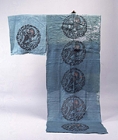Japanese Gallery (Honkan) Room 9
April 22, 2008 (Tue) - June 15, 2008 (Sun)
Bugaku is a type of music with accompanying dance performance, derived from those created in ancient China and Korea, and imported to Japan in the late 8th century. During the Heian period (794-1192) it developed a style unique to Japan as the official performing art at the imperial court, held during Buddhist ceremonies and for sheer entertainment. As the popularity of bugaku thrived, the costumes evolved and elements of aristocratic attire were incorporated into the exotic style, resulting in distinctive designs.
Since the initial refinement of the Japanese style, bugaku continued as a traditional theater art performed in Buddhist and Shinto festivals, using the traditional costumes, modified in accordance with changes to the aesthetic sense and textile techniques of subsequent periods. Unfortunately, due to the perishable nature of the costumes themselves, the number of surviving works is insufficient to accurately trace the history. Most of the extant bugaku costumes were used by Nanto Gakubu, the official bugaku troupe in Nara, or at temples, including Shitennoji in Osaka and Nikkosan Rinnoji in Tochigi, from the mid Edo (1603-1868) to Meiji periods (1868-1912). However, there are some earlier examples of costumes made in the medieval style, such as those from the Kamakura period (1192-1333) preserved at Toji (Kyoogokokuji) in Osaka, and the Muromachi period (1392-1573) preserved at Koyasan Amanosha in Wakayama. The Tokyo National Museum has been researching the history of bugaku costumes by creating copies of these. A selection of bugaku costumes and masks preserved at Koyasan Amanosha also forms part of the museum collection.
Many of the bugaku costumes previously featured in displays in the Main Gallery are of the style developed in the late Edo period, which continues to be used today. The current display also features examples from the Muromachi period, and copies of the costumes from the Kamakura period, to show the changes made to the designs of traditional bugaku costumes to acquire the present style.
Since the initial refinement of the Japanese style, bugaku continued as a traditional theater art performed in Buddhist and Shinto festivals, using the traditional costumes, modified in accordance with changes to the aesthetic sense and textile techniques of subsequent periods. Unfortunately, due to the perishable nature of the costumes themselves, the number of surviving works is insufficient to accurately trace the history. Most of the extant bugaku costumes were used by Nanto Gakubu, the official bugaku troupe in Nara, or at temples, including Shitennoji in Osaka and Nikkosan Rinnoji in Tochigi, from the mid Edo (1603-1868) to Meiji periods (1868-1912). However, there are some earlier examples of costumes made in the medieval style, such as those from the Kamakura period (1192-1333) preserved at Toji (Kyoogokokuji) in Osaka, and the Muromachi period (1392-1573) preserved at Koyasan Amanosha in Wakayama. The Tokyo National Museum has been researching the history of bugaku costumes by creating copies of these. A selection of bugaku costumes and masks preserved at Koyasan Amanosha also forms part of the museum collection.
Many of the bugaku costumes previously featured in displays in the Main Gallery are of the style developed in the late Edo period, which continues to be used today. The current display also features examples from the Muromachi period, and copies of the costumes from the Kamakura period, to show the changes made to the designs of traditional bugaku costumes to acquire the present style.

